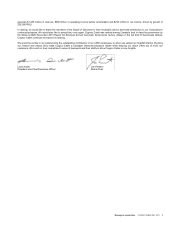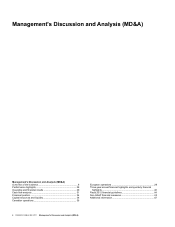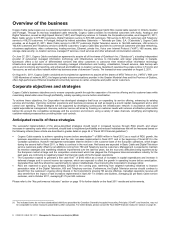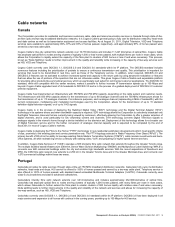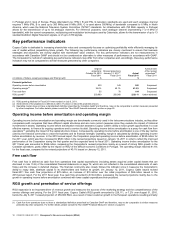Cogeco 2011 Annual Report Download - page 13
Download and view the complete annual report
Please find page 13 of the 2011 Cogeco annual report below. You can navigate through the pages in the report by either clicking on the pages listed below, or by using the keyword search tool below to find specific information within the annual report.12 COGECO CABLE INC. 2011 Management’s Discussion and Analysis (MD&A)
Capitalization of costs to acquire customers
The Corporation incurs significant costs to reconnect or activate additional services for Basic Cable, HSI, Digital Television and Telephony
service customers. These costs include material and labour costs incurred to reconnect or activate additional services for customers.
Reconnect and additional service activation costs are capitalized up to a maximum amount not exceeding the revenue generated by the
reconnect activity. These costs are amortized over the average life of a customer’s subscription, not exceeding four years. The average life of a
customer’s subscription is reviewed annually and changes could have a significant impact on the amortization expense.
Purchase price allocation
The allocation of the purchase prices for the Corporation’s acquisitions involves considerable judgement in determining the fair values assigned
to the tangible and intangible assets acquired and the liabilities assumed on acquisition. Among other things, the determination of these fair
values involves the use of discounted cash flow analyses, estimated future margins and estimated future customer counts. Should actual rates
and cash flows differ from these estimates, revisions to the carrying value of the related assets and liabilities acquired may be required,
including revisions that may impact net income in future periods.
Impairment of fixed assets and intangible assets with finite useful lives
The Corporation reviews, when a triggering event occurs, the carrying values of its fixed assets and intangible assets with finite useful lives by
comparing the carrying amount of the asset or group of assets to the expected future undiscounted cash flows to be generated by the asset or
group of assets. An impairment loss is recognized when the carrying amount of an asset or group of assets held for use exceeds the sum of
the undiscounted cash flows expected from its use and eventual disposal. The impairment loss is measured as the amount by which the asset
or group of assets’ carrying amount exceeds its fair value. Future cash flows are based on internal forecasts and consequently, considerable
management judgement is necessary to determine if a triggering event has occurred and to estimate future cash flows. Significant changes in
assumptions could result in an impairment of these assets.
Impairment of intangible assets with indefinite useful lives and goodwill
The valuation of customer base and goodwill is subject to review for impairment annually or whenever significant events or changes in
circumstances occur, to determine if the carrying value can be recovered. In conducting impairment testing, the Corporation compares the
carrying value to the sum of the expected future discounted cash flows. Future cash flows are based on internal forecasts and discounted by
using a weighted average cost of capital rate. Considerable management judgement is necessary to estimate future cash flows. Significant
changes in assumptions could result in an impairment of these assets. The Corporation’s annual impairment tests are performed at August 31
of each fiscal year.
Income taxes
The Corporation uses assumptions to estimate income tax expense as well as future income tax liabilities. This process includes estimating the
actual amount of income taxes payable and evaluating income tax loss carryforwards and temporary differences as a result of differences
between the values of the items reported for accounting and tax purposes. Realization of future income tax assets is dependent upon
generating sufficient taxable income during the period in which temporary differences are expected to be recovered or settled. The likelihood of
realization of future income tax assets is evaluated by considering such factors as estimated future earnings based on internal forecasts,
prudent and feasible tax planning strategies and reversal of temporary differences that result in future income tax liabilities. Future income tax
assets and liabilities are calculated according to enacted or substantively enacted income tax rates expected to be applied to taxable income in
the years in which those temporary differences are expected to be recovered or settled. Future income tax assets are recognized only to the
extent that, in the opinion of management, it is more likely than not that the future income tax assets will be realized. Accordingly, changes in
assumptions will directly impact the reported amount of income tax expense.
Foreign currency translation
Financial statements of self-sustaining foreign subsidiaries are translated into Canadian dollars using the rate in effect at the balance sheet
date for asset and liability items, and using the average exchange rates during the period for revenue and expenses. Adjustments arising from
this translation are deferred and recorded in the foreign currency translation adjustment in accumulated other comprehensive income and are
included in income only when a reduction in the investment in these foreign subsidiaries is realized.
Other assets and liabilities denominated in foreign currencies are translated into Canadian dollars at the exchange rates prevailing at the
balance sheet date for monetary items and at the transaction date for non-monetary items. Revenue and expenses are translated at the
average rates prevailing during the period except for transactions being hedged, which are translated using the terms of the hedges. Amounts
payable or receivable from cross-currency swap agreements, all of which are used to hedge foreign currency debt obligations, are recorded
concurrently with the unrealized gains and losses on the obligations being hedged. Other foreign exchange gains and losses are recognized as
financial expense, except for unrealized foreign exchange gains and losses on foreign-denominated long-term debt that is designated as a
hedge of a net investment in self-sustaining foreign subsidiaries, which are included in the foreign currency translation adjustment in
accumulated other comprehensive income, net of income taxes.





